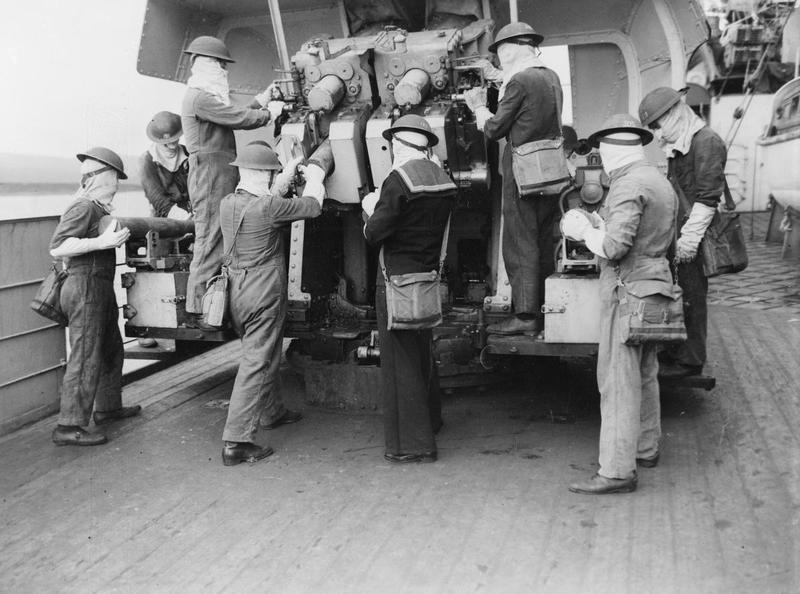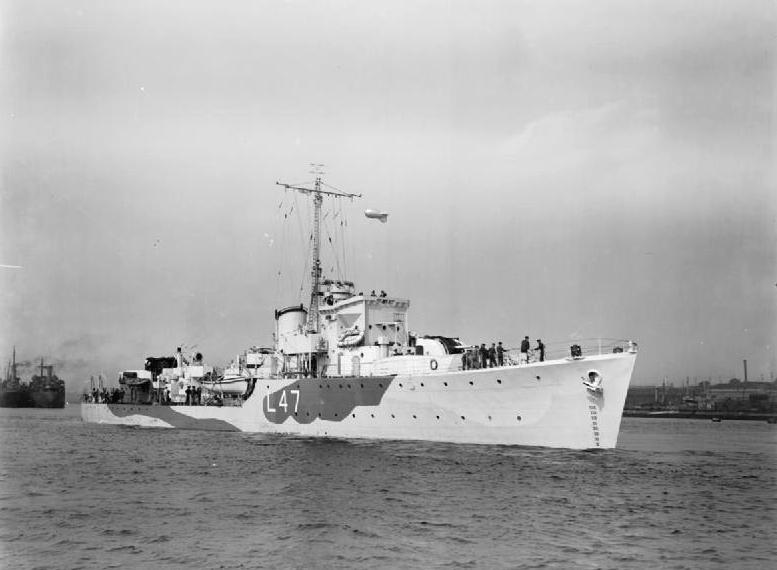|
QF 4-inch Naval Gun Mk XVI
The QF 4 inch Mk XVI gunMk XVI = Mark 16. Britain used Roman numerals to denote marks (models) of ordnance until after World War II. Mark XVI indicates this was the sixteenth model of QF 4 inch gun. was the standard British Commonwealth naval anti-aircraft and dual-purpose gun of World War II. Service The Mk XVI superseded the earlier QF 4 inch Mk V naval gun on many Royal Naval ships during the late 1930s and early 1940s. The ammunition fired by the Mk V gun and the Mk XVI guns was different. The Mk V ammunition was long and weighed , while the ammunition fired by the Mk XVI gun was long and weighed . The weight of the high-explosive projectile grew from for the Mk V to for the Mk XVI. There were three variants of the gun produced with differing construction methods. The original Mk XVI had an A tube, jacket to from the muzzle and a removable breech ring. The Mk XVI* replaced the A tube with an autofretted loose barrel with a sealing collar at the front of the jacket. ... [...More Info...] [...Related Items...] OR: [Wikipedia] [Google] [Baidu] |
Naval Gun
Naval artillery is artillery mounted on a warship, originally used only for naval warfare and then subsequently used for naval gunfire support, shore bombardment and anti-aircraft roles. The term generally refers to tube-launched projectile-firing weapons and excludes self-propelled projectiles such as torpedoes, rockets, and missiles and those simply dropped overboard such as depth charges and naval mines. Origins The idea of ship-borne artillery dates back to the classical era. Julius Caesar indicates the use of ship-borne catapults against Britons ashore in his ''Commentarii de Bello Gallico''. The dromons of the Byzantine Empire carried catapults and Greek fire, fire-throwers. From the late Middle Ages onwards, warships began to carry cannon, cannons of various calibres. The Mongol invasion of Java introduced cannons to be used in naval warfare (e.g. Cetbang by the Majapahit). The Battle of Arnemuiden, fought between England and France in 1338 at the start of the Hundred Y ... [...More Info...] [...Related Items...] OR: [Wikipedia] [Google] [Baidu] |
HMS Pretoria Castle (F61)
HMS ''Pretoria Castle'' (F61) was a Union-Castle ocean liner that in the Second World War was converted into a Royal Navy armed merchant cruiser, and then converted again into an escort carrier. After the war she was converted back into a passenger liner and renamed ''Warwick Castle''. History Harland and Wolff built ''Pretoria Castle'' in Belfast, launching her in 1938 and completing her in April 1939. The Admiralty requisitioned her for the Royal Navy in October 1939, and had her converted into an armed merchant cruiser with eight and two guns, entering service in November 1939. In this role she served mainly in the South Atlantic. In July 1942 the Admiralty bought her outright for conversion to an escort carrier by Swan Hunter on Tyneside. For her new role her armament included ten Oerlikon 20 mm cannon. She was commissioned in her new role in July 1943. She operated as a trials and training carrier, seeing no active combat service. In 1945 she twice became part of av ... [...More Info...] [...Related Items...] OR: [Wikipedia] [Google] [Baidu] |
River-class Frigate
The River class was a class of 151 frigates launched between 1941 and 1944 for use as anti-submarine convoy escorts in the North Atlantic. The majority served with the Royal Navy and Royal Canadian Navy (RCN), with some serving in the other Allied navies: the Royal Australian Navy (RAN), the Free French Naval Forces, the Royal Netherlands Navy and, post-war, the South African Navy. The first orders were placed by the Royal Navy in 1940, and the vessels were named for rivers in the United Kingdom, giving name to the class. In Canada, they were named for towns and cities, though they kept the same designation. Originally called a "twin-screw corvette", the name "frigate" was suggested by Vice-Admiral Percy W. Nelles of the Royal Canadian Navy. Canada originally ordered the construction of 33 frigates in October 1941. The design was too big for the locks on the Lachine Canal so it was not built by the shipyards on the Great Lakes and therefore all the frigates built in Canada wer ... [...More Info...] [...Related Items...] OR: [Wikipedia] [Google] [Baidu] |
Bay-class Frigate
The Bay class was a class of 26 anti-aircraft (A/A) frigates built for the Royal Navy under the 1943 War Emergency Programme during World War II (one of which was cancelled and six completed as despatch vessels or survey ships). They were based on the hulls of incomplete Loch class anti-submarine (A/S) frigates. In 1959 and 1961, four frigates of the class (''Bigbury Bay'', ''Burghead Bay'', ''Morecambe Bay'' and ''Mounts Bay'') were transferred to the Portuguese Navy. Between 1966 and 1968, based in Mozambique, these ships were part of the Portuguese naval deterrent force against the Royal Navy Beira Patrol which was trying to enforce sanctions against Rhodesia. In 1966 the Portuguese Navy also bought the survey vessel ''Dalrymple'' which served until 1983. Design The Bay class made use of the hull, machinery, lattice mast and superstructure of incomplete Loch-class frigates. The armament was altered to suit them to the A/A role, with twin QF 4 in Mark XVI guns fore and aft i ... [...More Info...] [...Related Items...] OR: [Wikipedia] [Google] [Baidu] |
Hunt-class Destroyer
The Hunt class was a class of escort destroyer of the Royal Navy. The first vessels were ordered early in 1939, and the class saw extensive service in the Second World War, particularly on the British east coast and Mediterranean convoys. They were named after British fox hunts. The modern Hunt-class GRP hulled mine countermeasure vessels maintain the Hunt names lineage in the Royal Navy. History The Royal Navy had identified the need for two types of destroyer: larger vessels with heavy gun and torpedo armaments for fleet work and another type for escort duties. Although old fleet destroyers could be allocated to escort work, they were unsuitable for the task and new construction replaced them. Fleet destroyers were designed for speed and their machinery was inefficient at convoy speeds, reducing their range. Their shape made them poor sea boats at low speed, also exacerbated by additional equipment on the superstructure. Modifications were needed to ease these problems. T ... [...More Info...] [...Related Items...] OR: [Wikipedia] [Google] [Baidu] |
HMS Petard (G56)
HMS ''Petard'' was a P-class destroyer of the British Royal Navy that saw service during the Second World War. She was one of only three P-class ships, out of the original eight, to survive the war in a serviceable condition. Originally to have been named HMS ''Persistent'', ''Petard'' was launched in March 1941. She initially carried the pennant number G56, which was changed after the war to F56. ''Petard'' had the distinction of sinking a submarine from each of the three Axis navies: the German , the Italian and the Japanese . Members of the ship's crew recovered from ''U-559'' a new, four-wheel Enigma cypher machine and the books to go with it,Jak P. Mallmann Showell, ''U-Boat Warfare'' p. 107 albeit at the cost of the lives of her First Lieutenant and an Able Seaman, both of whom were drowned when the U-boat they were searching sank with them inside. The early years ''Petard'' was launched on 27 March 1941 at Walker's shipyard in Newcastle, on the River Tyne.Harper, p. ... [...More Info...] [...Related Items...] OR: [Wikipedia] [Google] [Baidu] |
Tribal-class Destroyer (1936)
The Tribal class, or ''Afridi'' class, were a class of destroyers built for the Royal Navy, Royal Canadian Navy and Royal Australian Navy that saw service in World War II. Originally conceived during design studies for a light fleet cruiser, the Tribals evolved into fast, powerful destroyers, with greater emphasis on guns over torpedoes than previous destroyers, in response to new designs by Japan, Italy, and Germany. The Tribals were well admired by their crews and the public when they were in service due to their power, often becoming symbols of prestige while in service. As some of the Royal Navy's most modern and powerful escort ships, the Tribal class served with distinction in nearly all theatres of World War II. Only a handful of Royal Navy Tribals survived the war, all of which were subsequently scrapped from hard use, while Commonwealth Tribals continued to serve into the Cold War, serving with distinction in the Korean War. Only one Tribal survives to this day: , whic ... [...More Info...] [...Related Items...] OR: [Wikipedia] [Google] [Baidu] |
Roberts-class Monitor
The ''Roberts'' class of monitors of the Royal Navy consisted of two heavily gunned vessels built during the Second World War. They were the ''Roberts'', completed in 1941, and ''Abercrombie'', completed in 1943. Features of the class, apart from two 15-inch guns in a twin mounting (taken from two First World War era ''Marshal Ney'' class monitors), were shallow draught for operating inshore, broad beam to give stability (and also resistance to torpedoes and mines) and a high observation platform to observe fall of shot. Ships *: Reused the turret of the World War I monitor ''Marshal Soult''. ''Roberts'' provided bombardment support during Operation Torch in North Africa, where she was damaged by two 500 kg bombs. She was repaired in time to support the Allied invasion of Sicily, landings near Salerno, invasion of Normandy, and landing at Westkapelle. :One of ''Roberts guns (formerly in HMS ''Resolution'') is mounted outside the Imperial War Museum in Lambeth, S ... [...More Info...] [...Related Items...] OR: [Wikipedia] [Google] [Baidu] |
HMS Danae (D44)
HMS ''Danae'' was the lead ship of the cruisers (also known as the D class), serving with the Royal Navy between the world wars and with the Polish Navy during the latter part of World War II as ORP ''Conrad''. Service ''Danae'' was laid down on 1 December 1916 in the Armstrong Whitworth Shipyard in Walker-on-Tyne and launched on 26 January 1918. The lead ship of her class, she was one of the fastest cruisers of her time. Propelled by two Brown-Curtis steam turbines of , 6 boilers and 2 propellers, she could travel at . With 1,060 tons of oil in her tanks, she had a range of at 29 knots and at . She was also well armoured, with the sides and the command deck protected with of reinforced steel, the tanks and munition chambers with , and the main deck with . Attached to the Harwich-based 5th Light Cruiser Squadron, she took part in several North Sea patrols during the last months of World War I. Between October and November of the following year, she passed to the Balt ... [...More Info...] [...Related Items...] OR: [Wikipedia] [Google] [Baidu] |
Leander-class Cruiser (1931)
The ''Leander'' class was a class of eight light cruisers built for the Royal Navy in the early 1930s that saw service in World War II. They were named after mythological figures, and all ships were commissioned between 1933 and 1936. The three ships of the second group were sold to the Royal Australian Navy (RAN) before World War II and renamed after Australian cities. Design The ''Leander'' class was influenced by the ''York''-class heavy cruiser and was an attempt to better provide for the role of commerce protection. The 7,000-7,200 ton ''Leander''s were armed with eight BL 6 inch Mk XXIII naval guns in twin turrets, two forward and two aft. Their secondary armament consisted of four high-angle QF 4 inch Mk V naval guns, which were later replaced by twin mountings for eight guns (the later high angle QF 4 inch Mk XVI naval gun). Their close-range anti-aircraft weaponry consisted of twelve Vickers machine guns in three quadruple mounts. They also shipped a bank of four to ... [...More Info...] [...Related Items...] OR: [Wikipedia] [Google] [Baidu] |


.jpg)


